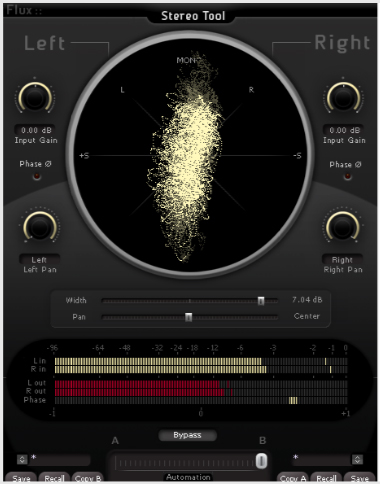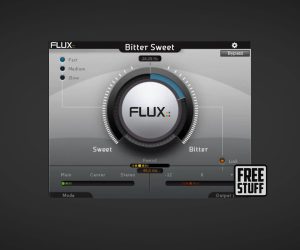
FLUX STEREO TOOL

There are many reasons why you may need extra width in your stereo sounds or two-channel mixes. Creating a sense of depth and dynamic without losing the central focus and bass strength is normally what you should look for in a ‘stereo widening’ software algorithm. Over the years, I’ve mostly been disappointed with the software variants on offer. So I was quite surprised when Flux’s new Stereo Tool plug-in (which is downloadable free from its website) turned out to be the best I’ve tried.
The Flux Stereo Tool readout has a vector scope display, PPM meters for both inputs and outputs, and a phase correlation meter permanently monitoring the signal. The Stereo Tool also offers individual left and right polarity reversal that are sadly lacking on the outputs of many DAWs.
The phase integrity of a stereo mix is easily determined by the clear, easy-to-view ‘jellyfish’ vector scope. If the information displayed on the meter (otherwise known as a goniometer) is lying horizontal, the stereo information is out of phase. Resolving this is simply a matter of pressing either the left or right inverter switches to flip one channel, and voilà! – the polarity is reversed and you’re in phase. Conversely, if the goniometer looks vertical, with little sideways movement, your mix is dominated by mono information – a true mono signal would be represented by a straight vertical line.
The correlation meter under the in/out meters relates to ‘relative phase’, i.e., how all the elements of the mix combine together. When it swings left you’re out of phase; right, and you’re in phase. A good mix should generally see this marker tending towards the right. Directly under the main scope are the width slider and pan controls. Pull the width slider to the left and you make the program material more mono; to the right and you’re widening. The pan control meanwhile, enables you to correct mixes that are lopsided.
At the bottom of the Stereo Tool is the ‘A to B’ slider, for instantly (or gradually) morphing between presets via your DAW automation – good for widening parts of songs for dramatic effect. A word of warning: wideners are seductive, and overusing them can weaken your bass sounds. A little goes a long way. Calum Orr
Flux: www.fluxhome.com/download/
















RESPONSES